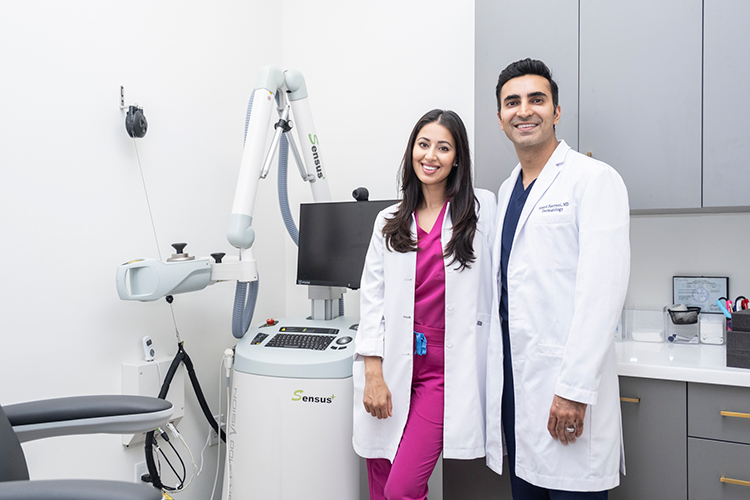
Being diagnosed with skin cancer is scary enough. But concerns are amplified when the cancer is on the face and surgery could be disfiguring.
“One in 5 people will develop some sort of skin cancer in the United States and the odds are even higher when you live in a sunny state like Florida,” said Dr. Anand Haryani, who owns and operates Iconic Dermatology with his wife Dr. Divya Haryani. “The majority of non-melanoma skin cancers are associated with the ultraviolet radiation from the sun, and since we have so much sunshine, skin cancers are prevalent.”
For many years, the main option was to surgically remove the cancer, possibly leaving a scar, or in some cases of cancer on the nose or ear, a disfiguration or amputation.
“Not everyone wants surgery anymore,” Dr. Anand Haryani continued. “Fortunately, there is now a non-surgical, noninvasive option called image-guided superficial radiation therapy that we are proud to offer in three of our four locations.”
Image-Guided Superficial Radiation Therapy uses low levels of X-ray energy to kill cancer cells and allow normal tissue to grow back in its place. High-resolution ultrasound visualization is used to determine tumor size to guide the scope and energy level of the radiation treatment. The high-resolution ultrasound is performed during each treatment and after completion in order to make real-time modifications and assessments for treatment response.
Patients who have been diagnosed with basal cell carcinoma, squamous cell carcinoma or some other form of non-melanoma skin cancer and have been told they need Mohs surgery are candidates for the new laser treatment.
Iconic Dermatology has partnered with a company called GentleCure to provide this innovative treatment to their patients. GentleCure radiation therapists are highly trained in the use of the radiation treatment device and are full-time employees stationed in each local Iconic Dermatology office. A team of physicists and radiation oncologists at GentleCure’s corporate offices reads the scans in real time to determine the type and depth of the cancer and set parameters of where the margins will be. A physicist calibrates the machine and determines the radiation dosages.
“We’ve partnered with GentleCure because they are the experts in the field and they have the offsite personnel with the expertise to do the calculations to say how much radiation they want to give to this area,” Dr. Divya Haryani added. “Ultimately, they are our patients, so we oversee the entire process to make sure everything is going as planned.
And every office has its own full-time radiation therapist to ensure continuity of treatment for the patient.”
With Image Guided SRT, the patient sits in a chair and a gel is applied at the site of the cancer. Using an imaging wand, the doctors can look at a detailed image of the cancer on a screen and measure the size and shape of the affected area, calculate the treatment dose and define the treatment area.
Once complete, the arm of the device will be placed over the treatment site and the exact dose of X-ray energy will be used to precisely target the cancer site, penetrating only a few millimeters into the patient’s tissue without harming the healthy tissue around it.
Each treatment takes about 15 minutes with 20 treatments given over a five-week period.
Before each treatment, the ultrasound measures the depth of the remaining cancer and changes the dosage of radiation if needed.
The most recent study on Image Guided SRT published by biomedical.com shows a cure rate of greater than 99 percent, which is equal to the success rate with Mohs surgery. That is without cutting, bleeding or surgical scarring, no recovery time, no anesthesia and no risk for short- or long-term nerve damage, which can occur with Mohs surgery – though Mohs is generally safe and effective. Science Daily reported in a 2020 article that 95 percent of patients were satisfied with the outcome of their Mohs surgery.
“We are currently the only practice on the Treasure Coast offering the Image Guided SRT,” Dr. Anand Haryani claimed. “We treat about 20 patients a day in each location and so far the patients have been very satisfied. The ultrasound gives us the ability to look under the skin and actually see the roots of the cancer and then target just the area that is affected. It’s definitely the new wave of treatment.”
Iconic Dermatology has grown from one to four locations in less than three years.
“Our goal was always to open a practice in central Vero but there wasn’t the right property available when we started,” Dr. Anand Haryani said. “So we opened our location in Wabasso and expanded to Barefoot Bay and Melbourne, yet we were still busting at the seams. When the building in Vero became available, we went for it, spent a year renovating it, and opened in November last year. We’ve grown from just three employees to 35 and we now have the ability to serve the Vero/Sebastian/Melbourne area completely.”
“Now that we’ve gone through our growing process, we intend to continue focusing on delivering the best possible care for all of our patients,” Dr. Divya Haryani concluded.
Both doctors are board certified dermatologists. Dr. Anand Haryani graduated from Southern Illinois University School of Medicine and received his dermatology training at John H Stroger Jr. Hospital of Cook County in Chicago. Dr. Divya Haryani attended the University of Central Florida College of Medicine and completed her residency in dermatology at the University of South Florida and Moffitt Cancer Center in Tampa, Florida. They see patients at their offices in Vero Beach, Wabasso, Barefoot Bay and Melbourne. Call 772-247-6224 or visit iconicderm.com to get more information or make an appointment.



